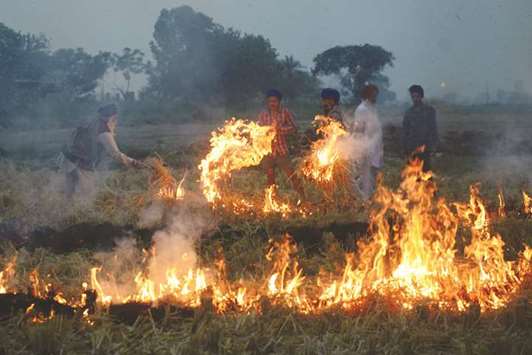A sandstone quarry near the village of Sirohi, on the outskirts of New Delhi, is a reminder that it’s not just fireworks and crop burning that are causing the capital’s pollution problems.
The site was previously part of the Aravalli mountain range, that stretches nearly 700km through northern and western India.
That was until hundreds of workers hollowed out one of its hills, mining for rocks and sand for construction.
It is the same in many other parts of the Aravallis, which used to protect Delhi from dust rolling in from the nearby Thar Desert.
Beginning in October, stubble farmland around Delhi, along with vehicle and industrial emissions, and the lighting of firecrackers during festivals combine to create a toxic haze that can hang over the city for months.
Environmental experts say the dust blowing in from surrounding areas, which are becoming increasingly arid due to rising temperatures and shrinking forests, also plays a role in Delhi’s pollution woes.
In May and June, the capital was hit by huge dust storms that forced residents indoors and cancelled flights, worrying authorities in a period that outside the main “pollution season” between October and December.
“Mines are making forests shrink, and the mountains used to block sand from other areas,” said Kailash Bidhuri, founder of Save Aravalli, an environmental group attempting to stop the mining of the hills around Delhi.
“What you see now is the result.”
The fast disappearance of the hills has also started to worry the Supreme Court.
In a long-running case brought by environmental activists against several defendants, the court recently heard evidence from the government’s Forest Survey of India, which said it conducted a study of 128 hills and found that nearly a quarter of them had disappeared.
The court said last month rampant mining was making Delhi’s already-toxic air even worse, and ordered an immediate halt to illegal mining in one small section of the range.
But it’s doubtful the limited ban will have much impact.
Similar bans over the years have been ignored.
Government studies of mining areas in the Aravallis have found significant increases in cases of asthma and silicosis, an incurable respiratory infection caused by the dust the mines kick up.
Compounding the problem, at many mining sites, workers dig below the permitted levels, polluting water supplies, Bidhuri said.
“There were rules and protocols that were not followed,” Bidhuri said.
The hill at Sirohi has been dug out, broken up and hauled away, and the mine bosses have moved on to begin again on another hill.
Left behind are villagers who miss the old days, despite the health dangers, both for them and for Delhi’s residents.

Farmers burn rice straw after harvesting the paddy crops in a field on the outskirts of Amritsar yesterday.
